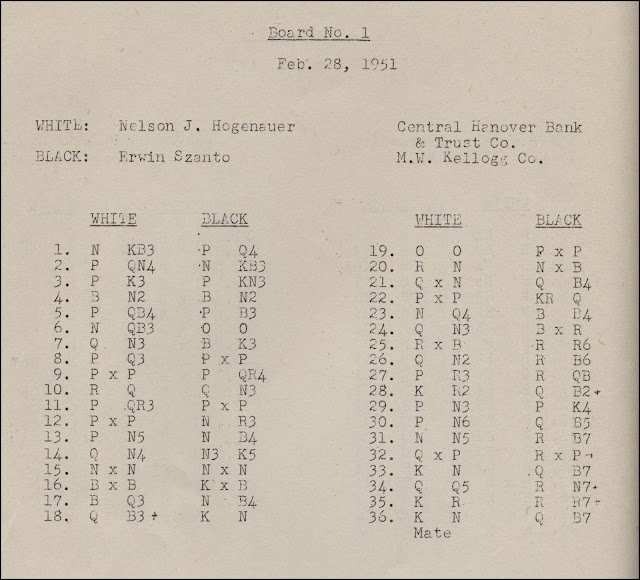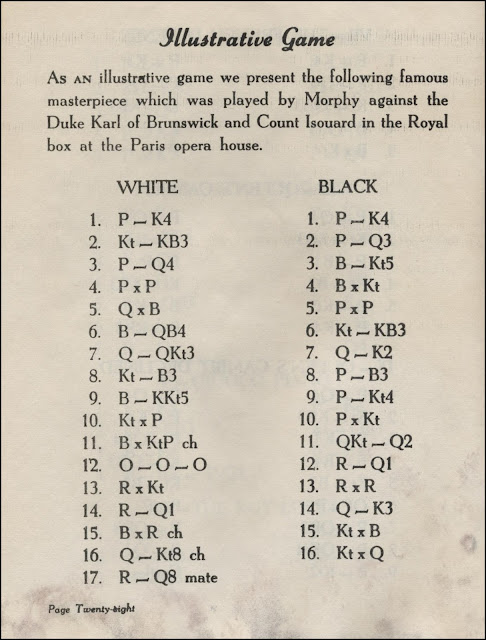The Year-Book of Chess, 1913, London 1914.
It was All Change Here! this year; the title page now includes "Founded by E.A.Michell", and the Preface announces that the Year-Book has changed hands and is now the exclusive property of Mr. Frank Hollings. Several improvements were planned for this and future editions, including "a tolerably complete list of all works on the game published during the twelve months". Unfortunately this did not come to pass.
Some regular features of previous editions had been omitted to make room for new material this year; namely an article on Kriegspiel by W. H. Stephens, Brilliancies, with examples of recent striking short games, and a 44 page Addendum with particulars and games from the early part of 1913.
There is also a Review of Modern Chess Openings, second edition (revised), 1913, by R. C. Griffiths and J. H. White. This concludes:
The General Review of the Year was written by E. A. Michell and the main events from 1912 were the international tournaments at San Sebastian, Pöstyen, and Breslau, each won by Rubinstein, (jointly with Duras at Breslau). However, Michell again comments that "England is very nearly non-existent as far as International Chess is concerned" This was the final contribution from Michell who subsequently pursued his career as a concert director.
Several other events are detailed in the 220 odd pages of tournament and match coverage including a third match between Marshall and Janowsky in Biarritz, 1912, and the Alechin v Levitzky match held in St. Petersburg, 1913.
Here are a couple of interesting adverts at the back of the book:
The Year-Book of Chess, 1914, edited by M. W. Stephens, London 1915.
The outbreak of war in Europe was not only blamed for the late publication of this edition but, more seriously, caused a hiatus in international competition for several years. The main event in 1914 was the Grand International Masters' Tournament at St. Petersburg, for which entries were extended to include Alechin and Niemzowitsch, and where Emanuel Lasker and Capablanca met over the board for the first time. Many other tournaments and matches are reported on including the unfinished Mannheim Tournament.
New features this year include the End-Game Section by C. E. Cecil Tattersall:
Also Periodical Chess Literature, giving details of dedicated chess periodicals and newspaper and magazine chess columns from around the world. The editor acknowledges that this first attempt at such a list is "lamentably deficient" but hoped to improve on this in future years.
There are articles on Chess Organisation in Great Britain by R. H. S. Stevenson, A Brief History of the Ponziani by W. H. Watts, The Muzio Gambit by T. Hamilton, and Kriegspiel by W. H. Stephens.
Several books are reviewed this year including two of A. C. White's Christmas Series books, and Chess Strategy by Edward Lasker, reviewed by.... Edward Lasker!
Ed. Lasker's review continued for another two pages.
Other books reviewed include The Grand International Masters' Chess Tournament at St Petersburg, 1914, The Second Player in the Chess Openings by Colonel R. K. Teversham**, and Staunton's Chess Player's Handbook, revised and edited by E. H. Bermingham, which is slated. But the promised list of new works on chess did not appear.
** The Second Player in the Chess Openings, London 1914, is mentioned in a, tongue in cheek, remark by Michael MacDonald Ross on page 102 of Bob Meadley's must read for chess book buffs: A Letter to Bert, (A medley about chess libraries, dealers and collectors), available online.
 |
| From page 102 of A Letter to Bert |
The selection of Brilliancies includes the following:
An advert for Mortimer's Chess Player's Pocket Book claims that this "has enjoyed a larger circulation than any other book on chess that has ever been published". A wild statement not borne out by the number of surviving copies.
The Year-Book 0f Chess, 1915 and 1916, edited by W. H. Watts and A. W. Foster, London 1917.
The editor for the 1914 Year-Book had departed for military service and the joint editors for this final edition were W. H. Watts and A. W. Foster. The Problem Section had also changed hands from P. H. Williams to H. G. Hughes.
The Preface, by the joint editors, gave the usual apology for the lateness of publication and acknowledged that, in the absence of the Continental chess magazines, they had drawn heavily from the chess columns of The Field, (now conducted by Amos Burn). The editors also welcomed the new Chess Annual for 1915, published by British Chess Magazine, viewing this as a supplementary work rather than a rival publication.
There were no major international tournaments during these two years and it was often difficult to obtain information on the few events that did take place. However, the editors managed to include reports and games from the New York Masters' Tournament of 1915 and the Rice Memorial Tournament of 1916, both won by Capablanca, and 100 pages are devoted to these events.
The Leopold Trebitsch Tournaments of 1914 and 1915, both won by Schlechter, are included, as are various tournaments amongst the Russian players interned in Germany, in which Bogoljuboff fared particularly well, winning three of the tournaments reviewed and finishing second to Flamberg in the other.
Articles:
Some Historic Blunders. W. H. Watts gives over twenty examples by famous players.
Problem Tourneys and their Methods. G. W. Chandler discusses some of the difficulties in conducting satisfactory problem tournaments.
Chess Coincidences. W. H. Watts highlights some similarities in chess problem compositions, positions reached in over-the-board play, and even whole games, citing striking similarities between Lasker-Bauer, Amsterdam 1889 (game No. 2 in Dr. Lasker's Chess Career by Fred Reinfeld), and Niemzowitsch-Tarrasch, St. Petersburg 1914. (game No. 24 in the tournament book mentioned above). Watts concludes his article with the following chess doomsday scenario:
In another chapter on Kriegspiel, Alfred W. Foster claims that "the Year-Book contains the only authoritative information on Chess Kriegspiel which has been published in the English Language."
The End-Game Section by Tattersall and the Problem Section by Hughes make their final appearance, and the adverts at the rear include these recommendations by Frank Hollings:
And so ended the ten year run of this useful and informative publication, which had often been produced under difficult circumstances, but which had provided an important record of world chess events.
© Michael Clapham 2017




































































